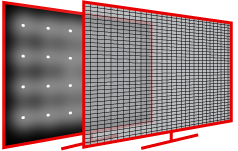- Table of Contents
- Intro
- Plasma
- LCD
- Conclusion
- Comments
For most of the early 2000s, plasma and Liquid Crystal Display (LCD) TVs were competing to earn the market share in TV sales. Each type used its own technology to display an image, and each had its own pros and cons. By 2007, LCD TVs dominated the TV market because they cost less and were readily available, and although Panasonic, LG, and Samsung all stopped producing plasma TVs by 2014, many people may still have their old plasmas.
This article explains how each TV technology displays an image and the differences between them. You can learn about it in more detail here.
Plasma
Plasma screens contain tiny pockets of gas that get excited when voltage is applied to them, turning them into a state of plasma. In that state, the voltage then strikes electrons of mercury, turning them into ultraviolet (UV) light, which isn't visible to the human eye. The UV light then passes through phosphor cells; each pixel contains red, green, and blue phosphor cells. Thanks to these phosphor cells, the TV can turn the UV light into colors that are visible on the light spectrum. Essentially, plasma TVs don't require a light, and each pixel is self-emissive, so how one pixel displays itself is independent of the next pixel.
Since each pixel emits its own light, blacks are really deep. When the television wants to display black, it simply emits no light at all for the selected pixels. However, these aren't perfect blacks because each pixel retains a bit of voltage, leaving a bit of light to pass through. Each pixel emits light in all directions, creating wide viewing angles, so the image remains accurate when viewing from the side.
The pixels aren't excited continuously, but in short pulses, and some plasma TVs can pulse up to 600 times every second. The naked eye perceives this as flickering, and some people are very sensitive to this. There can also be some advantages to this; since each pixel holds a certain charge, it's ready to turn on and off as needed, resulting in minimal motion blur. This means that fast-moving content, like in sports or video games, appears smooth.
One of the downsides of plasmas was how they suffered from occasional image retention if they displayed the same image for a long period. So if you watched the news for about an hour, with all of its static displays, then switch channels, you'd still see the outline of the static elements. Eventually, they disappeared, but it could have been particularly annoying. Also, after several years in use, plasmas suffered from permanent burn-in. This happened when the phosphor cells simply stayed stuck in one color and couldn't display any colors. Unfortunately, there was no way to avoid eventual burn-in, and almost every plasma TV suffered from it.
OLED TVs have similar characteristics to plasmas with their infinite contrast ratio, wide viewing angles, near-instant response time, and to a lesser extent, the risk of permanent burn-in. Since 2012, they've replaced plasma as a competitor to LCD TVs, and to learn more about OLEDs and how they differ from LCD TVs, see here.
LCD

An LCD screen is composed of two parts: the actual liquid crystal display and a light source at the back of the screen (called backlight). A light diffuser is placed between the backlight and the LCD screen to make the source of light uniform across the screen.
The LCD panel doesn't emit light by itself, and this is why it needs a backlight; it only acts as a filter to block the light on a per-pixel basis. The backlight is always on, and the pixels in the display rotate to allow light through, creating the colors needed for the image. If the screen wants to display black, the LCD pixels rotate to try to block the light completely. If it wants to display white, it lets all light through. Since the display is only a filter, the blacks will not be as deep as with a plasma screen because an LCD panel will always let a small portion of light through.
There are different types of LCD panels, each with its unique characteristics. Vertical Alignment (VA) panels generally have a high contrast ratio and narrow viewing angles, while In-Plane Switching (IPS) panels have a low contrast ratio with wide viewing angles. You can read about their differences here.
By using a backlight, LCD TVs use much less power than plasmas, which you can read about here. Also, LCD TVs tend to get much brighter than plasmas, making them more suitable for well-lit rooms. There are two main types of backlights used in LCD screens: CCFL and LEDs.
CCFL

When someone refers to an LCD TV, they usually mean a Cold-Cathode Fluorescent Lamp (CCFL) backlit LCD screen. The first LCD TVs were lit by CCFLs, but they're extremely rare as of the start of the 2020s. The backlight is a series of light tubes placed behind the screen. These tubes are very similar to fluorescent lamps used in buildings but smaller.
CCFL-backlit LCD TVs were eventually replaced by LED TVs because they cost less, were made thinner, and required less power. Also, LED TVs have more control over their backlight, resulting in vivid colors and better picture quality.
LED
An LED (Light-Emitting Diode) screen is an LCD screen, but instead of having a normal CCFL backlight, it uses LEDs as the source of light behind the screen. Companies label their TVs as LED, even though they're technically LCD; it can be confusing at times, but if you see an LED TV, you know it has an LCD panel. These TVs are more energy-efficient and a lot smaller than CCFLs, enabling a thinner television screen.
There are three main configurations of LED as backlights for television screens: full-array, edge-lit, and direct-lit.
Full-Array

This method is considered the best LED backlight type and is usually found on higher-end models, but as of 2020, some mid-range models have it too.
In a full-array LED screen, the LEDs are distributed evenly behind the entire screen. This produces a more uniform backlight and provides more effective use of local dimming, where it can turn off and dim complete zones of LEDs.
Edge-Lit

Many lower-end TVs and most monitors use this backlight type.
With an edge-lit LED screen, the LEDs are placed at the edges of the screen. Depending on the display, it can be all around the screen, on the left and right sides, or at the top and bottom. This allows the screen to be very thin.
However, it can cause some spots on the screen to be brighter than others, like the edges. This problem is called flashlighting or clouding. It can be seen when watching a dark scene in a dark environment. Also, edge-lit screens usually don't result in good local dimming as they don't have control over the dimming zones.
Direct-Lit

Direct-LED TVs are similar to full-array, but generally don't have a local dimming feature; this is found on lower-to-mid-range TVs.
Like the full-array method, the LEDs are directly behind the screen. However, there are very few of them, and they can't be controlled separately to match the luminosity of the picture.
These TVs aren't very thin because of the space required behind the screen to add the LEDs.
The future: Mini and micro led?
As TV companies attempt to improve their technology, a new type of LED backlighting has emerged: Mini LED. It uses the same traditional LED backlighting behind an LCD panel, except the LED lights are even smaller. This allows for more lights, creating a brighter image and more control over local dimming. Only a handful of Mini LED TVs were produced before 2021, but it now seems that manufacturers are starting to use the technology more often. The Samsung QN90A QLED is an example of a Mini LED TV.
Another technology, Micro LED, is only in its initial phases of development. This doesn't even have an LCD panel as each LED pixel is self-emissive, similar to OLEDs, but without the burn-in risk. Currently, there aren't any Micro LED TVs available at the consumer level; Samsung has produced large Micro LED TVs (over 100 inches), and they're very expensive. However, we may begin to see Micro LED technology in the consumer TV market soon.
Conclusion
Plasma and LCD each present advantages and disadvantages when it comes to picture quality. Plasma TVs generally offer better contrast, wider viewing angles, and improved response times, while LCD TVs get much brighter and have better reflection handling. LCDs also cost less and can be much thinner, which are two of the main reasons why they took over the market share from plasmas in the mid-2000s. Plasma TVs are now extinct, and although OLEDs share many of the same characteristics, LED-backlight LCD TVs are now the norm, and it's likely your next TV purchase will have an LCD panel.













































